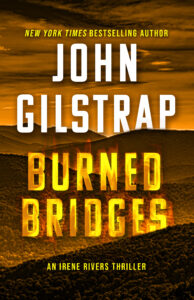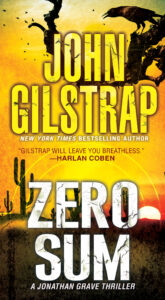For the 29th time in 29 books in a row, I find myself in the same predicament: roughly a month to go before deadline and woefully behind where I want to be. And not to sound cocky and not to jinx things, I’m confident that somehow, for the 29th time in 29 books in a row, I’m going to pull it all together and cross the line before the buzzer.
 The book on the X at the moment is Burned Bridges (Spring/Summer, 2025), the first installment of my new series featuring Irene Rivers, the FBI Director from the Jonathan Grave series. The very existence of the series is a bit of a spoiler for the next Grave book, Zero Sum (August, 2024), but that’s pretty much unavoidable. Because this is the first book in a series, I’m taking my time in building the world in which she lives in West Virginia. It’s bucolic yet corrupt–I write thrillers, after all–but my corrupt players are smart and educated, just like the vast majority of real West Virginians I’ve come to know since we moved here.
The book on the X at the moment is Burned Bridges (Spring/Summer, 2025), the first installment of my new series featuring Irene Rivers, the FBI Director from the Jonathan Grave series. The very existence of the series is a bit of a spoiler for the next Grave book, Zero Sum (August, 2024), but that’s pretty much unavoidable. Because this is the first book in a series, I’m taking my time in building the world in which she lives in West Virginia. It’s bucolic yet corrupt–I write thrillers, after all–but my corrupt players are smart and educated, just like the vast majority of real West Virginians I’ve come to know since we moved here.
 Also, the Irene Rivers series will not be Jonathan Grave with a female protagonist. This series will be more subtle. Less explosive. Driven out of Washington by the political implosion she caused, she’s living out in the country now on inherited family land, trying to reconnect with her kids and be as invisible as possible. To give herself a little something to do, she hangs out her shingle as a private investigator.
Also, the Irene Rivers series will not be Jonathan Grave with a female protagonist. This series will be more subtle. Less explosive. Driven out of Washington by the political implosion she caused, she’s living out in the country now on inherited family land, trying to reconnect with her kids and be as invisible as possible. To give herself a little something to do, she hangs out her shingle as a private investigator.
Last week, as I crossed the 75,000-word mark, I realized that I’d created a problem for myself. I had characters I really liked doing interesting things with snappy dialogue to solve perplexing problems. What I didn’t have was a pervasive sense of menace. No one felt the presence of danger–including the reader, I’m afraid. I had big reveals planned for the third act in the midst of big violence, but I hadn’t given the reader a reason yet to recognize who my bad guys were, let alone dread their presence in a scene. Third act reveals don’t matter if readers aren’t still there to experience them.
Remember, I write thrillers, and one of the chief differences between my genre and mysteries is that it’s fine for the reader to have more perfect knowledge than the protagonist. I realized that instead of saving all the good stuff for the third act, I needed to open up a parallel storyline for my bad guys and transfer some of the violence up front. Right away, the pacing improved, and my bad guys started to feel more real to me. We come to see that much of the bad they do is necessary in their minds to prevent larger problems from being uncovered. Readers might not agree with their methods, but at least they’ll understand their motivations. The additional storyline also grants the impression of time passing between Irene’s scenes as she moves from place to place.
 When I teach master classes–as I will be in September at the Rocky Mountain Fiction Writers Conference in Denver–I emphasize that a story is an engineered product. The purpose of the product is to take readers on an emotional journey with characters that feel real to them. The writer is the engineer who makes every decision from yes or no on the Oxford comma to paragraph length to the perfect balance of action, description and dialogue. If I do my job right with these latest changes, the casual readers of Burned Bridges will have no idea that certain plot points exist where they do as the result of late-in-the-cycle structural repairs. Instead, they will feel perfectly organic to the story.
When I teach master classes–as I will be in September at the Rocky Mountain Fiction Writers Conference in Denver–I emphasize that a story is an engineered product. The purpose of the product is to take readers on an emotional journey with characters that feel real to them. The writer is the engineer who makes every decision from yes or no on the Oxford comma to paragraph length to the perfect balance of action, description and dialogue. If I do my job right with these latest changes, the casual readers of Burned Bridges will have no idea that certain plot points exist where they do as the result of late-in-the-cycle structural repairs. Instead, they will feel perfectly organic to the story.
When things don’t feel right on a project, never hesitate to pump the brakes and take a hard look at what might be pulling your narrative astray. If you find yourself working too hard to keep revealing secrets to your reader while still having a story that makes sense, consider a structural change that will allow the reader to know the secret and then concentrate instead on keeping the protagonist in the dark. That could be as simple as a POV change.
If you find yourself drowning in the choreography of a love scene or a fight scene, consider having your characters merely close the door or run away.
The engineering of a story depends on the niche you’re hoping to fill. I drive a very nice Jeep Wrangler while my wife drives a very nice BMW X3. We’re both very happy with our vehicles. Mine is louder and bouncier than hers on purpose, not as a mistake in engineering. A young wealthy neighbor drives a Porsche that is essentially a massive engine with wheels attached. Neither of our cars would scratch his itch. (I’ve never sat in his Porsche because I’m afraid someone would post a video of me trying to get out of it.)
Your turn, Zoners. Does this engineering approach resonate with your own approach to writing? If you’re a plotter, do you always avoid late term panic attacks like mine? Pantsers, can you relate?

Your post gives me food for thought, Mr. Gilchrist. Although I have three-quarters of a novella completed, when I read it over last week I realized the plotline lacked a sense of urgency in the first half. I’ve been thinking about where and how to add a few scenes that deliver that feeling. Your strategy gives me a new way to approach this gap in my story. Thank you!
My mainstream novels are heavily engineered. I plot with Dramatica, compare my structure to that of skyscrapers (you don’t get those to work high above the ground unless the building design gets water and electricity up, and waste down), and know from the very beginning where the plot is going, so all the threads lead to the end.
Everything is designed to increase the microtension.
Every scene has a purpose and a set of goals and parameters – and I write linearly, one scene after another.
When I get stuck, it’s because something seems to have deeper resonances than I planned, and I have to stop and see what my subconscious is trying to tell me (I’m in one of those holes right now at the beginning of the last novel in the trilogy).
But even the new stuff fits into the structure – I just hadn’t noticed yet.
Once the structure is solid, it is SO much easier to do the writing, and to avoid going down blind alleys and having to get rid of ‘darlings.’ I can be as flighty and creative as I like in the language and dialogue and detailed setting – because I know it’s all connected – by design.